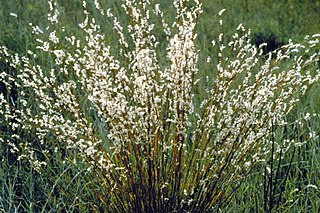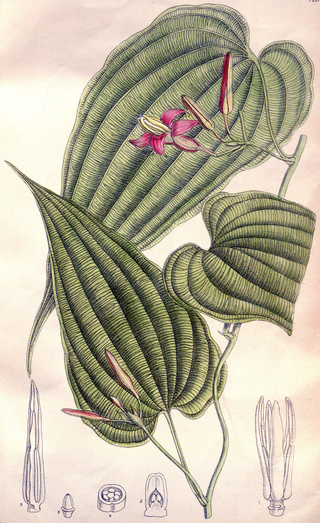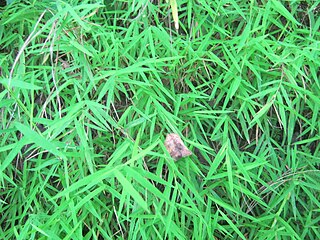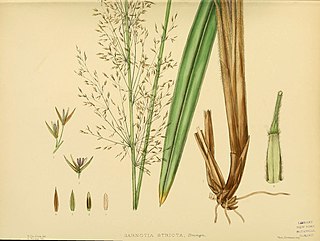| Eulalia | |
|---|---|
 | |
| Eulalia aurea | |
| Scientific classification | |
| Kingdom: | Plantae |
| Clade: | Tracheophytes |
| Clade: | Angiosperms |
| Clade: | Monocots |
| Clade: | Commelinids |
| Order: | Poales |
| Family: | Poaceae |
| Subfamily: | Panicoideae |
| Supertribe: | Andropogonodae |
| Tribe: | Andropogoneae |
| Subtribe: | Saccharinae |
| Genus: | Eulalia Kunth |
| Type species | |
| Eulalia aurea (Bory) Kunth [1] | |
| Synonyms [2] [3] | |
| |
Eulalia is a genus of Asian, African, and Australian plants in the grass family. [1] [4] [5] [6] [7]
Eulalia was named after the French botanical artist Eulalie Delile. [8]
As a common name, "eulalia" refers to a grass in a different genus, Miscanthus sinensis . [9]
- Species [3] [10]
- Eulalia annua – Australia
- Eulalia aurea – silky browntop – Australia, Thailand, Vietnam, Madagascar, Réunion, eastern + southeastern Africa (from Kenya to Mpumalanga)
- Eulalia bicornuta – Thailand, Myanmar
- Eulalia brevifolia – Yunnan
- Eulalia contorta – China, Indian subcontinent, Southeast Asia
- Eulalia fastigiata – Indian subcontinent, New Guinea, Vietnam
- Eulalia fimbriata – Indian subcontinent, Myanmar, Thailand, Vietnam, Java, Lesser Sunda Islands
- Eulalia hirtifolia – Assam, Bhutan, Myanmar
- Eulalia leptostachys – New Guinea
- Eulalia leschenaultiana – Fujian, Guangdong, Jiangxi, Taiwan, Indian subcontinent, Southeast Asia
- Eulalia mackinlayi – Australia
- Eulalia madkotiensis – Uttarakhand [11]
- Eulalia manipurensis – Manipur, Assam, Bhutan, Bangladesh, Myanmar
- Eulalia maritima – Philippines
- Eulalia milsumi – Bukit Lompat Bayan in Selangor [12]
- Eulalia mollis – Tibet, Uttarakhand, Nepal, Sikkim, Bhutan, Assam
- Eulalia monostachya – Cambodia, Thailand, Vietnam
- Eulalia pallens – Myanmar, Assam, Guangxi, Guizhou, Sichuan, Yunnan
- Eulalia phaeothrix – India, Sri Lanka, Myanmar, Thailand, Vietnam, Hainan, Sichuan, Yunnan
- Eulalia polyneura – Ethiopia, Kenya, Tanzania, Zambia, Mozambique
- Eulalia pruinosa – Yunnan
- Eulalia ridleyi – Peninsular Malaysia, Borneo
- Eulalia shrirangii – Maharashtra [13]
- Eulalia siamensis – Myanmar, Thailand, Laos, Yunnan
- Eulalia smitinandiana – Thailand
- Eulalia splendens – Guangxi, Guizhou, Yunnan
- Eulalia staintonii – Uttarakhand, Nepal
- Eulalia tetraseta – Thailand, Cambodia
- Eulalia thwaitesii – India, Sri Lanka
- Eulalia villosa – golden velvet grass – southern Africa, Madagascar, Thailand, Yunnan, India
- Eulalia yunnanensis – Yunnan
- formerly included [3]
see Andropogon Bothriochloa Microstegium Miscanthus Polytrias Pseudopogonatherum Schizachyrium Spodiopogon
- Eulalia amaura – Polytrias indica
- Eulalia argentea – Pseudopogonatherum trispicatum
- Eulalia bequaertii – Microstegium fasciculatum
- Eulalia birmanica – Pseudopogonatherum speciosum
- Eulalia cantonensis – Microstegium vimineum
- Eulalia capensis – Microstegium nudum
- Eulalia ciliata – Microstegium fasciculatum
- Eulalia clarkei – Bothriochloa kuntzeana
- Eulalia collina – Pseudopogonatherum contortum
- Eulalia concinna – Pseudopogonatherum contortum
- Eulalia cotulifer – Spodiopogon cotulifer
- Eulalia densa – Miscanthus floridulus
- Eulalia dispar – Microstegium dispar
- Eulalia eucnemis – Microstegium eucnemis
- Eulalia filifolia – Pseudopogonatherum filifolium
- Eulalia glabrata – Microstegium glabratum
- Eulalia gracillima – Microstegium glabratum
- Eulalia grata – Microstegium fasciculatum
- Eulalia hydrophila – Andropogon lima
- Eulalia irritans – Pseudopogonatherum irritans
- Eulalia japonica – Miscanthus sinensis
- Eulalia koretrostachys – Pseudopogonatherum contortum
- Eulalia lagopus – Pseudopogonatherum trispicatum
- Eulalia lanipes – Pseudopogonatherum speciosum
- Eulalia mexicana – Bothriochloa barbinodis
- Eulalia monantha – Microstegium fasciculatum
- Eulalia nana – Polytrias indica
- Eulalia nepalensis – Miscanthus nepalensis
- Eulalia nuda – Microstegium nudum
- Eulalia paniculata – Andropogon tenuiberbis
- Eulalia parceciliata – Microstegium fasciculatum
- Eulalia quadrinervis – Pseudopogonatherum quadrinerve
- Eulalia rufispica – Microstegium rufispicum
- Eulalia setifolia – Pseudopogonatherum contortum
- Eulalia simplex – Schizachyrium fragile
- Eulalia speciosa – Pseudopogonatherum speciosum
- Eulalia spectabilis – Microstegium spectabile
- Eulalia tanakae – Pseudopogonatherum speciosum
- Eulalia tenuis – Microstegium tenue
- Eulalia trispicata – Pseudopogonatherum trispicatum
- Eulalia tristachya – Pseudopogonatherum trispicatum
- Eulalia vagans – Microstegium fasciculatum
- Eulalia velutina – Pseudopogonatherum speciosum
- Eulalia viminea – Microstegium vimineum
- Eulalia zebrina – Miscanthus sinensis
















